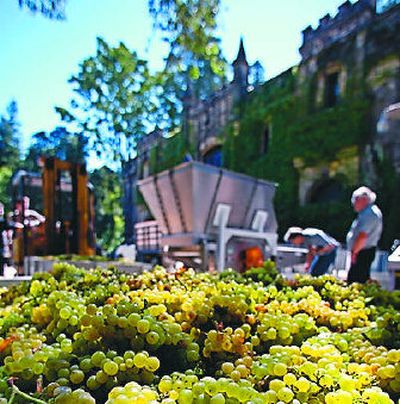Wine, grapes pump up U.S. economy

ROCHESTER, N.Y. — With 935,000 acres of vineyards and grape farms, nearly 5,000 wineries and 1.1 million jobs, the wine-and-grape industry sends an estimated $162 billion rippling through the U.S. economy each year, a consulting firm said.
Wineries were the biggest contributors, generating $11.4 billion in sales, an industry-commissioned study by MKF Research LLC found. But wine, grapes and related foods and drinks also had a far-reaching economic effect on a wide array of businesses, from tourism and agriculture to trucking and real estate.
“It generates a lot of employment, pays a lot of taxes, involves thousands and thousands of people across the country,” Barbara Insel, managing director of MKF Research in St. Helena, Calif., said Wednesday.
The national study spotlights a bustling arena that suffers from inadequate federal funding, a scarcity of skilled labor and the vagaries of weather and consumer tastes, wine industry advocates say.
“This is a more important industry than we thought it was,” said Jim Trezise, president of the New York Wine & Grape Foundation. “So when we’re making new laws or budgets, let’s keep in mind that we would like to see further growth of this industry so it can contribute more to the economy.”
While California accounts for 90 percent of all wine production and virtually all table grapes and raisins — grape juice is made primarily in Washington state, New York, Pennsylvania and Michigan — the number of wineries soared from 2,688 in 1999 to 4,929 in 2005. They’re popping up in all 50 states.
In North Carolina, 44 new wineries have opened in the last decade as 1,000 acres of vineyards replaced tobacco and other crops diminishing in value. Most of New York’s 239 wineries have appeared only in the last 25 years, and the growth rate has doubled since 2000, Trezise said.
“In the ‘90s, 63 wineries opened in New York,” he said. “In the first five years of this decade, there were 63 more.”
Half of the state’s wineries have sprouted in the Finger Lakes region in west-central New York, where a grape-friendly micro-climate is created by deep, slender, hill-framed lakes.
Vince Bedient, 77, who’s been growing grapes on the steep hillsides above Keuka Lake since 1965, said half of his 103-acre crop goes to wineries and half to juice makers. But he and his son, Jim, are now scrambling to replace native labrusca grapes with more popular European vinifera and hybrid varieties.
Their business, which survived a severe slump in the juice market in the 1980s, “is really not that great yet but it’s coming,” Bedient said.
Replacing the vines costs $10,000 an acre but “if we can get varieties that are in demand up and in production, it’s going to be lucrative again,” he said. “I have all kinds of optimism about the future of New York and the wine industry.”